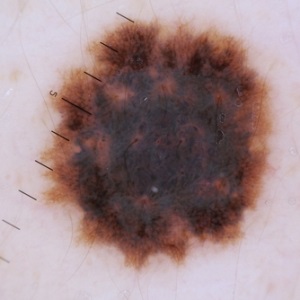
Mrs K’s case is an illustration of complicated illness where a good clinician will only be to make the correct diagnosis with proper history taking and physical examination. In the modern day, clinicians are completely overwhelmed by patient numbers and either the history taking or the physical examination (or both) takes the back stand so the doctor can consult as many patients as possible.
On History taking the following is of vital importance:
Prior medical history: Mrs K mole should highlight suspicion. Details surrounding the reason why the “mole” was removed should be asked. When suspicious looking moles get removed they’re sent off to an anatomical pathologist to evaluate their nature – are they malignant? Ask about any available reports.
Are there any other associated symptoms with her significant weight loss? One has to exclude infective causes like TB – ask about coughing, night sweats and contact with other sick people.
On physical examination:
Check the site of “mole” removal. For a lay patient, doctors explain medical terminology as easy as possible. A “mole” might be a suspicious skin lesion.
On Abdominal examination: feel for organomegaly (Enlarged abdominal organs like the liver or spleen)
Check for any possible cause for vomiting after meals – vomiting straight after meals are concerning and should be looked for in all cases.
In Mrs K’s case: her paleness should raise suspicion about an underlying pathology. The fact that she’s becoming more tired and looks pale suggest of a gradual decrease in haemoglobin - most likely anaemia of chronic disease.
On abdominal examination the doctor found an enlarged liver pressing on her stomach and causing her to vomit. An enlarged liver should always be investigated with imaging (Ultrasound or CT if indicated) and laboratory testing. A number of conditions can cause an enlarged liver.
On further examination the site of Mrs K’s mole is of further importance. The site of her “mole” turned out not to be a mole only. (Again, the patient may think it is a mole, but in fact, it might be something more sinister). In Mrs K’s case this was the most important breakthrough. Melanomas often “hide”. Foot soles and palms are of particular importance to examine. Look carefully! In dark skins lesions are often missed. Moles on the soles of feet are rare and any dark spots larger than 6 mm, with irregular borders, growing rapidly, or multiple colours should be examined. This is important in all suspicious looking skin lesions.
SUMMARY:
Mrs K most likely have metastatic melanoma which will explain her massively enlarged liver causing her to vomit after meals. Her paleness and tiredness is most likely due to an anaemia of chronic illness (as often found in the case of malignancy). She should be appropriately referred for imaging of her abdominal organs, blood tests and evaluation of her “mole” site.
Image: Nevus Nevus typically permanent brown or red mark on someone's body from birth




 Publications
Publications
 Partners
Partners














